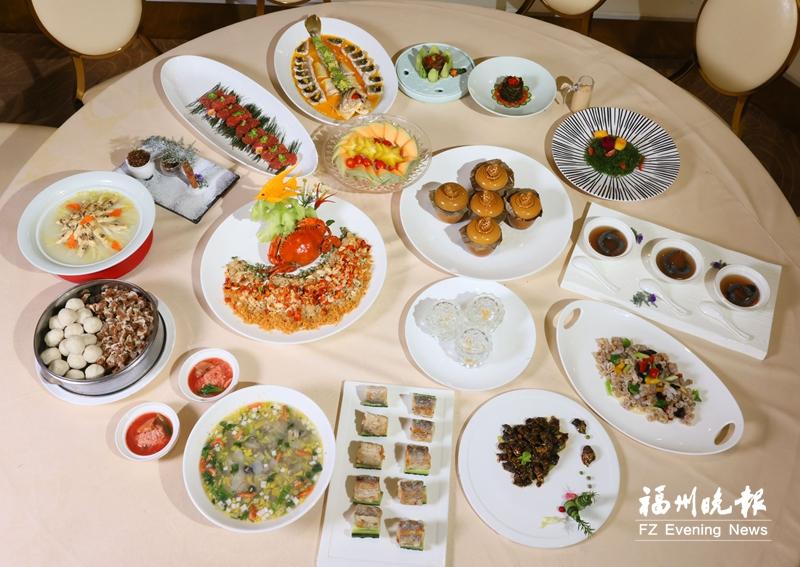Going Global! Featured on CCTV! “Fuzhou-made” Products Are Gaining Widespread Attention
Fuzhou and Matsu share the same roots in culinary culture. As Fuzhou pursues its bid for “City of Gastronomy,” it is also working to build a “shared living circle” with Matsu. Today, seafood from Fuzhou, including sea cucumbers, sea urchins, and abalone, has not only become a key feature of the Lianma Family Banquet, but is also making its way overseas, competing for orders in international markets.

Lianma Family Banquet Featuring Sea Cucumber and Abalone As Key Ingredients. (Photo/Reporter: Bao Hua)
CCTV praises “Fuzhou-produced” seafood
Like Fuzhou’s signature seafood abalone, sea cucumbers and sea urchins are also part of the “Eight Treasures of the Sea” and key ingredients in Fotiaoqiang, the “No. 1 dish of Fujian cuisine.” On the 23rd and 24th, CCTV Finance Channel (CCTV-2) spotlighted Fuzhou’s sea urchin and sea cucumber industries, covering stories like Prime Season: How to Properly Enjoy Sea Urchins and Southern Farming of Northern Sea Cucumbers Brings a Bump Harvest in Lianjiang, Fujian, highlighting the success of Lianjiang’s innovative aquaculture model.
According to reports, fishermen at the sea cucumber farming base in Dinghai Village, Xiaocheng Town, Lianjiang, have been busy harvesting sea cucumbers from plastic fishing rafts recently. “Last October, I purchased 150,000 kilograms, or about 4 million sea cucumber seedlings, from Dalian,” said Zhao Shisong, a local farmer. “We harvest around 50,000 kilograms of sea cucumbers every day, with each kilogram selling for over 80 yuan.”
Just a few months ago, these sea cucumber seedlings were still resting on the seabed in northern waters. According to reports, fishermen along the Lianjiang coast have developed an innovative model of “Southern Farming of Northern Sea Cucumbers.” Every October, they purchase sea cucumber seedlings from the north and transport them south to “overwinter.” Thanks to the warm climate in the southern regions during winter, the sea cucumbers do not enter hibernation and continue to grow, greatly shortening the farming cycle. Moreover, Dinghai Bay boasts excellent water quality and calm seas, providing an ideal environment for sea cucumber cultivation. According to statistics, the total number of sea cucumbers farmed in Lianjiang this year has exceeded 50 million, with the expected total yield reaching over 6,500 tons.
Similarly, sea urchins have also been successfully cultivated in Fuzhou. “This is my first year trying to farm sea urchins. We released over 300,000 sea urchin seedlings, and the largest ones have now grown to more than 4 cm,” said farmer Lin Chuanbin. He added that the yield of this batch of sea urchins is expected to exceed 10,000 kilograms, with a total value of over 2 million yuan.
For a long time, China’s sea urchin farming has been primarily concentrated in Liaoning and Shandong in the northern part of China, with Fuzhou sourcing most of its sea urchins from these northern regions. “Currently, the survival rate of Strongylocentrotus intermedius seedlings cultivated in Lianjiang has reached 70% to 80%, and they are also being sold to cities such as Rongcheng in Shandong and Dalian in Liaoning,” said Wang Weigang, an engineer at the Lianjiang Ocean and Fishery Bureau. Since 2021, Lianjiang County has initiated sea urchin breeding trials and developed a “north-south relay” farming model for Strongylocentrotus intermedius. This involves transporting the sea urchins to Rongcheng, Shandong during the summer to escape the heat, and then bringing them back to Lianjiang for the winter. This model has effectively improved the survival rate and quality of the sea urchin seedlings.
Create the Lianma Family Banquet, while expanding to secure international orders
Lianjiang County, separated from Matsu by the sea, skillfully blends elements from both Lianjiang and Matsu to create the Lianma Family Banquet, featuring 17 uniquely crafted dishes. Among them, “Mountain and Sea Delicacies in a Pot,” made with the ingredients of abalone, sea cucumbers, and razor clams, has been praised by diners as the “Little Fotiaoqiang.”
Sea urchins and sea cucumbers are just a glimpse of Fuzhou’s seafood offerings. From April 23 to 25, the 30th Seafood Expo Global was held at Fira Barcelona in Spain. As one of the world’s top three seafood expos, it serves as a vital platform for Chinese seafood companies to expand into the EU and global markets.
Several seafood processing companies from Fuzhou, including Rixing Foods, Public Health, Yida Foods, Xuhuang Foods, Zhengguan Fishery, and Mintong Wanhai, participated in the event. The high-quality seafood products showcased by companies under the “Hai Lian Jiang” regional public brand garnered widespread acclaim from both domestic and international buyers, drawing a large number of visitors for discussions. By April 24, companies from Lianjiang had secured intended orders totaling over 50 million yuan.
Looking ahead, Lianjiang will focus on developing a variety of economically significant aquatic species, including abalone, oysters, Manila clams, razor clams, kelp, nori, and yellow croakers. The city plans to nurture a number of leading enterprises with core competitiveness in integrated breeding, propagation, and promotion, alongside modern seed industry bases. It aims to establish a more competitive, modern fisheries industry system, creating a comprehensive industrial chain for modern ocean ranching which spans from seed industry, aquaculture, and equipment to deep processing. (Fuzhou Evening News Reporter: Zheng Ruiyang; Correspondent: Lian Rongmei)